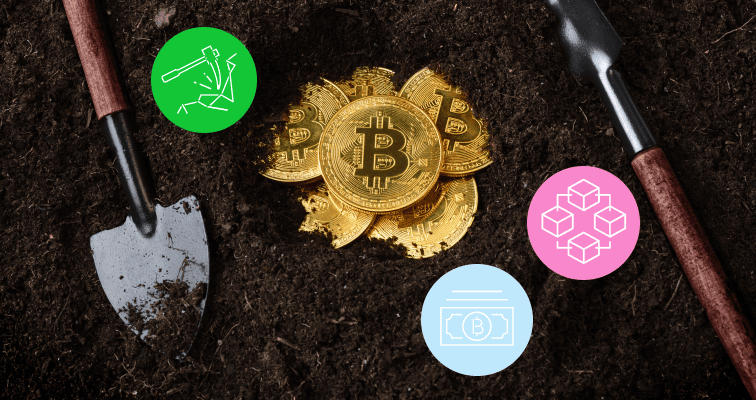Bitcoin is a decentralized digital currency that was created in 2009 by an unknown individual or group using the pseudonym Satoshi Nakamoto. It is the first and most well-known cryptocurrency. It operates on a peer-to-peer network without the need for intermediaries such as banks or governments.
The jargon surrounding Bitcoin can be confusing, but the underlying principles are relatively straightforward. Developing a better understanding of Bitcoin starts with studying the innovative technology that allows it to be used to make transactions or to store wealth.

What is Bitcoin?
Bitcoin is a
Bitcoin uses
How does Bitcoin work?
The Bitcoin network is structured as a blockchain. In this type of distributed ledger, transactions are grouped together in blocks, which are then timestamped and added to a chain.

All transactions are public for everyone on the network to verify and cannot be changed once added to the ledger. As each block in the chain contains a record of multiple transactions, once a block is added to the chain, the transactions within it cannot be altered or deleted. This ensures the integrity and
Tip: You can monitor Bitcoin transactions made by you and other parties using a blockchain explorer.
How do Bitcoin transactions work?
A Bitcoin transaction is simply any transfer of value across the Bitcoin network and follows a standardized format.
- The sender opens their Bitcoin wallet.
- The sender scans or copies the public key of the receiver’s wallet.
- The sender completes the remaining transaction information, including the amount being sent and the fees they are willing to pay to complete the transaction.
- The sender signs the transaction using their private key.
- The transaction is transmitted to the Bitcoin network.
- Miners find the transaction along with a set of other transactions and group them into a block.
- The fastest miner to successfully verify the block posts it to the blockchain and receives a mining reward.
- Blockchain nodes verify the validity of the block, and the transaction is confirmed.
How do you hold Bitcoin?
Physical bitcoin does not exist, and instead, information about your holding in bitcoin will be found in a Bitcoin
| Public key | Private key |
|---|---|
| Used in receiving bitcoin, a public key can be shared with anyone without the fear of theft. In fact, a public key can be used to view all transactions to and from any Bitcoin wallet. | Used in sending bitcoin, a private key should never be shared under any circumstances. A private key is what keeps a wallet secured. |
There are several types of wallets, including software wallets, hardware wallets and paper wallets, each with varying levels of security and convenience.
Tip: One way to keep your Bitcoin accessible and secure is to download the eToro Money crypto wallet.
What is Bitcoin mining?
New bitcoins are created through a process called
The total supply of Bitcoin is limited to 21 million coins, and as more coins are mined, the difficulty of the mathematical problems increases, ensuring a steady and controlled release of new bitcoins into circulation.
Tip: The Bitcoin halving occurs approximately every four years and impacts the mining and supply of coins.
Bitcoin criticisms
While many believe that Bitcoin will ultimately be the native currency of the internet, it has come up against several criticisms of its design and network that it will have to overcome in order to ultimately succeed.

Bitcoin energy consumption
Bitcoin protocols rely on miners who use substantial amounts of energy to process their calculations and secure the network. Many question whether such excessive energy consumption is worth the reward.
Some Bitcoin miners are beginning to move toward renewable energy sources to power their mining equipment, such as solar and wind power, but it remains to be seen whether this will reduce the carbon footprint of the Bitcoin network enough to make the blockchain environmentally friendly.
No intrinsic value
No one really knows what Bitcoin is worth. The whole concept is relatively new, and nothing like it has ever existed before. While comparisons to gold are common, Bitcoin is different because it seemingly has no intrinsic value.
Gold is a physical asset that can be used in jewelry making, electronics, and dentistry. Yet Bitcoin has no value in and of itself and instead only derives value from what others are willing to pay for it. Some believe that without intrinsic value, trading Bitcoin is a worthless endeavor.
Government regulation
The Bitcoin network itself may be decentralized and unable to be censored, but this doesn’t mean that governments can’t make it difficult for users to access Bitcoin-related products and services. Governments have already taken steps to shut down local Bitcoin businesses and ban foreign exchanges, among other things.
Government crackdowns could halt Bitcoin investing in its tracks, and this is a substantial risk considering that governments have a vested interest in supporting fiat currencies over which they have more control.
Transaction speed
It takes time for the Bitcoin blockchain to process all the transactions on the network. While technological advances continue to reduce the amount of time needed, BTC is a long way from challenging the convenience of instant transaction times offered by fiat currencies.
Tip: As much as investors hope Bitcoin will replace fiat currencies, it is a speculative asset that experiences dramatic price moves.
Final thoughts
Bitcoin has come a long way since its early days as a relatively unknown digital asset. Today, millions of people are talking about Bitcoin as the next evolution of money, specifically designed for the web.
Bitcoin does have its fair share of question marks and issues to overcome. However, buying Bitcoin today is easier than ever as both consumers and businesses realize its potential.
Learn more about Bitcoin and other cryptocurrencies on the eToro Academy.
FAQs
- When was Bitcoin created?
-
The idea for Bitcoin was envisioned by a pseudonymous figure called Satoshi Nakamoto, who released his Bitcoin whitepaper on October 31, 2008. However, it took a few months before Satoshi decided to put his idea into action.
On January 3, 2009, the Bitcoin network came into existence when the first block of the Bitcoin blockchain, also known as the genesis block, was mined by Satoshi. For mining the genesis block, Satoshi was rewarded with 50 bitcoins (BTC).
- What is a Bitcoin fork?
-
Due to its decentralized nature, the Bitcoin community hasn’t always been in agreement on the best course of action for the network. Over the years, this has created forks of the crypto, which has resulted in new blockchains claiming that they are the original Bitcoin.
It is estimated that there are more than 20 forks of the Bitcoin network, with new cryptos created along the way. At the same time, entirely different blockchain networks have developed to create a market of Altcoins.
- What was before Bitcoin?
-
In the 1990s, there were several attempts at creating a crypto for the masses. One notable attempt was a currency called Bit Gold created by Nick Szabo. Bit Gold utilized a similar Proof-of-Work model used by Bitcoin today, but the project never gained much traction outside of hardcore enthusiasts.
There was also Hashcash, which was proposed by programmer Adam Back in 1997. Back would eventually be a key player in the development of Bitcoin, but only after Hashcash fizzled out. While none of these projects ever got off the ground, they helped lay the foundation for what was to come.
This information is for educational purposes only and should not be taken as investment advice, personal recommendation, or an offer of, or solicitation to, buy or sell any financial instruments.
This material has been prepared without regard to any particular investment objectives or financial situation and has not been prepared in accordance with the legal and regulatory requirements to promote independent research. Not all of the financial instruments and services referred to are offered by eToro and any references to past performance of a financial instrument, index, or a packaged investment product are not, and should not be taken as, a reliable indicator of future results.
eToro makes no representation and assumes no liability as to the accuracy or completeness of the content of this guide. Make sure you understand the risks involved in trading before committing any capital. Never risk more than you are prepared to lose.


